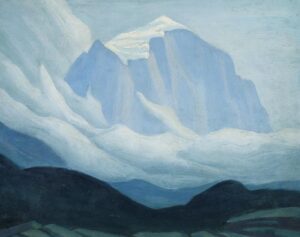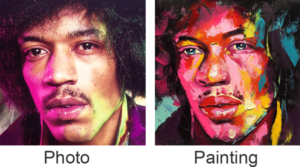“Amazon of the North: James Bay Revisited” comprised several shows at once: documentation of Hydro-Quebec’s interventions in Northern Quebec; reiteration of the vulnerability of the Cree people inhabiting the region; and an exhibition of politically-based art intended to bring awareness through formal expressiveness. Considered as a political declaration, the exhibition was both evocative and powerful. German collaborators Rainer Wittenborn and Claus Biegert, artist and journalist, respectively, sought to make a statement that would resonate across time. They shied away from haranguing their audience, most of whom were likely already deeply sympathetic to the plight of the Cree people.
Wittenborn and Biegert have presented such material before. In 1981 the two produced a multimedia exhibition, highly documentary in nature, entitled “James Bay Project: A River Drowned by Water.” The show was based on three months of collecting information of all kinds – images, words, biological specimens and artifacts. Unlike many of the anthropologists and travelers who collected data and then were never seen again, Wittenborn and Biegert ensured that their stay was characterized by regard for their Cree hosts. Indeed, the show opened in the Cree village of Chisasibi before touring throughout the world. In turn, the Cree’s Grand Council invited them back in 1989 to report on recent changes in Northern Quebec.
“James Bay Revisited” is starkly resonant. It remains openly, perhaps naively, divided about its dual allegiance to art and politics. Housed in three interconnecting rooms, the art sometimes felt thin in material terms, even as it argued with eloquence that the hydroelectric project would result in immense cultural suffering and ecological devastation. The conflation of political and aesthetic messages demanded an unusual technique; many of the pieces evidence a kind of visionary didacticism, in which a part stood for a much larger whole.
The first gallery held a large, computer-generated printout of a caribou, meant to symbolize a catastrophe brought about in September 1981 when Hydro-Quebec directed overflow from the Caniapiscau reservoir into the Caniapiscau River. This decision was based on economic expediency, for if the surplus water was released through the power plants, the power would have been impossible to market. According to the wall text, Hydro-Quebec opened the gates for twenty-five days, and the resultant overspill killed ten thousand caribou migrating across the river toward their winter home. The Inuit people of Kuujjuag helped clean up the site, a week-long job that cost close to $600,000. With stunning hubris, Hydro-Quebec announced that the flooding was an act of God. The computer image is based on an actual photograph of the disaster: a caribou buck nearly overwhelmed by white water. The pathos of its repetition across the wall is initially numbing – until one invests the work with historical fact and consequent feeling. In fact, the show’s hortatory and aesthetic power revolved around the quality of the audience’s response – that is, the intellectual and ethical passion brought to the image.
In a show such as this historical awareness dictates everything. As Armin Zweite observed in the 1981 catalogue, “Wittenborn … groups all the cited facts around a context of suffering which, of course, no longer conveys itself directly, [but] rather unfolds itself alone in the consciousness of the viewer.” In other words, the real change, both aesthetic and political, is supposed to occur inside one’s head. This rings true. Wittenborn challenges monumental power with quiet images that stay close, aesthetically and historically, to Cree culture. As a result, often the show’s meaning must be expanded by a particular knowledge of the politics involved.

This was especially evident in the exhibition’s last space, containing large prints of five young Cree women. In their own right, these photographs conferred no innate meaning, except, perhaps, the suggestion of an anthropological study. Once again, exhibition notes proved not only informative but necessary. The young women are future mothers, photographed in a local hospital. It appears that the huge reservoir – flooding more than 4,200 square miles of Cree land – has been responsible, along with acid rain, for the presence of mercury in the food chain. Pregnant women have been warned not to eat fish at all. Wall notes made it clear that the Cree women, presented so impassively, are in fact being tested for mercury levels that could deform their children. With such background material, the photograph of a simple strand of hair assumed poignancy – that is, if one knew that mercury levels can be determined by analyzing hair samples. As in all the works, the image is meant to instruct and move at the same time.
The exhibition’s middle room, holding two mixed-media installations, was devoted to Hydro-Quebec’s effect on marine life. Last Dance for a New Skin had as its primary image a white whale drawn in outline on black fabric. About where its heart would be were two audio speakers emanating the animal’s calls and cries. The catalogue explains that the whales stay close to the rivers after shedding their skin, preferring freshwater to saltwater. If the second part of the James Bay project is completed, the rivers will be diverted and the whales will have to go elsewhere. Such changes would deprive the Inuit living in the area of a regular food supply.
For now, the political subtext of “James Bay Revisited,” the Great Whale Project, is off (there is, however, no guarantee that project will not be resumed). Wittenborn and Biegert must be congratulated for their effective melding of historical data, political perception and aesthetic form. Still, larger questions are unanswered. For the collaborators, working as transmitters of propaganda, there is no difference between the issues and the aesthetic means with which they express them. In a sense, the individual works are meant to stand as discrete events in the thoughts of someone committed to saving the ecology of James Bay. By fostering awareness of the problems facing the Cree, the art is admirable; but it also tends to be visually oversubtle. Viewers must bring much background information to their experience of the art, and it is primarily in light of what they know that their perception is energized. The wall texts and catalogue proved absolutely necessary for the comprehension of the art.
In many ways, Wittenborn and Biegert profoundly politicize what they create by reversing the usual experience of an exhibition – they would like us to think first and then perceive. Yet there has been a cost: their work sometimes possesses a formal isolation only the prose of a historical document might bridge. Involved in collaboration, the two men must have realized how their purposes and methods would sometimes split – that the intuitive communication of the artist and the factbased writing of the journalist would inevitably diverge. As political communication, the show demonstrates an acute awareness of its own intentions. Viewed as art, it becomes slightly less effective, for the filling in of gaps requires rigorous effort. The patience Wittenborn and Biegert ask – evident in the way the viewer needs time to take historical knowledge and use it to bracket and expand a formal perception – suggests new ways in which contemporary art can posit a spontaneous world, wherein our perception and our readiness to act coexist at exactly the same moment.




